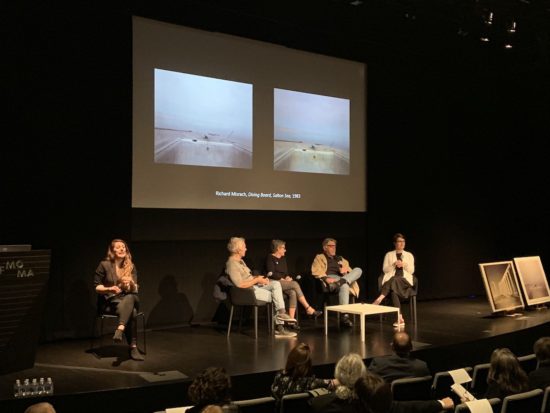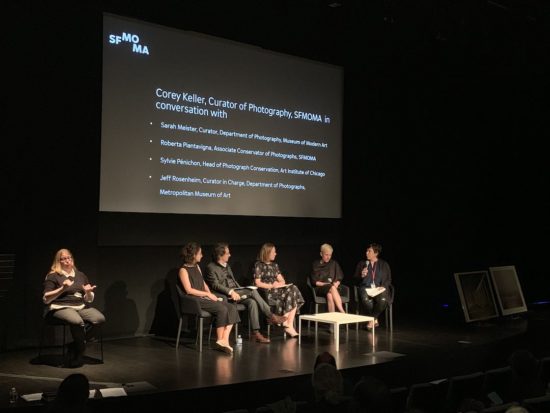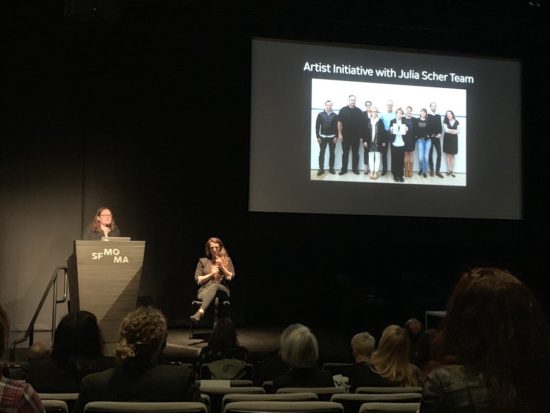This week’s contributing author, Michelle N. Jones, graduated with a Masters of Art in Museum Studies from San Francisco State University majoring in curatorship and higher education. She also holds a Bachelor’s degree in Studio Practice and Art History with a passionate emphasis in photography, post-war and contemporary art, and contemporary Islamic art. She has worked in private art collections, academic museums, and, most recently, as a graduate research intern at the San Francisco Museum of Modern Art.
For the final phase of the Artist Initiative’s research on the practice of reprinting color photography from the 1970s and 1980s, the San Francisco Museum of Modern Art (SFMOMA) hosted a day-long public symposium for curators, artists, conservators, and producers from the field of photography on May 10, 2019.[1] The symposium brought together international colleagues to collaboratively discuss the diverse questions, concerns, and research surrounding the reprinting of color photography in museum collections as a preservation strategy.[2]
As color photography became a more popular platform in the 1970s and 1980s, the art world quickly realized that chromogenic color prints were volatile. Due to rapid yellowing and fading of the photographs, galleries and museums hesitated when collecting, exhibiting, and selling color photography—some even said that it was a vulgar practice and that color was a frosting rather than a reality.[3] The instability of materials and the widely-accepted opinion that color photographs were not to be considered fine art left color photography devalued by the art market. Conflicting materials combined with continuous improvements in printing technology makes the discussion of reprinting for conservation and exhibition a complicated one.
The Artist Initiative’s intent for the culminating symposium was to include in the dialogue the voices of the curator, conservator, artist, and the producer to allow each stakeholder to voice their concerns equally and to emphasize that the decision to reprint is not solely that of the museum who stewards the photograph. Four important points surfacing in phases one and two of the Artist Initiative’s research were noted in the symposium’s introduction by SFMOMA’s Erin O’Toole: (1) everyone acknowledges that there is a problem with color photographs; (2) no one has a policy in place; (3) conservators and curators are conflicted about reprinting; and (4) terminology is a problem in the field as no set language exists.
Colleagues who presented topics from their area of expertise included Sarah Meister, Curator of Photography at the Museum of Modern Art; Sylvie Pénichon, Head of Photograph Conservation at the Art Institute of Chicago; Monica Marchesi, Paper Conservator at the Stedelijk Museum in Amsterdam; artists Janey Delaney, John Divola, and Richard Misrach; private practice conservator Peter Mustardo; and recom ART’s Markus Müller of Berlin. SFMOMA experts included Clément Chéroux, Senior Curator of Photography; Corey Keller, Curator of Photography; Linde Lehtinen, Assistant Curator of Photography; Erin O’Toole, Baker Street Foundation Associate Curator of Photography; Roberta Piantavigna, Associate Conservator of Photographs; and Robin Clark, Director of the Artist Initiative.
Experts presented on numerous topics including: the history of reprinting photographs, philosophical and ethical frameworks on the topic of reprinting photographs, the artist’s view on reprinting, issues and challenges with reprinting color photographs, the conservator’s perspective on reprinting contemporary color photography, the producer’s view on reprinting possibilities, and reprinting as a preservation practice.
The Artist’s Perspective
Relatively few artists were producing color photography in the 70s and 80s and this gave the symposium’s artist panel with Janey Delaney, John Divola, and Richard Misrach an individual and distinctive tone. Because the processing of color photographs was not accessible to artists at the time, the authorship of their work was under the control of expensive color processing labs and varying darkroom techniques.
While most artists would agree that reprinting with new technology presents a better-quality print to the museum’s collection and the viewer, there was no consensus from the panel on whether an artist should reprint based on the fact that new technologies can reveal more information about the original negative. The concern that photographers did not have access to the technology and materials they do today was brought up when the panel discussed the artist’s role in the decision to reprint as well as the retention of the artist’s intent in the original image. The scalability and contrast of early color works were limited, giving the photographs hidden potential.
Contemporary photographers sit on both sides of the argument and final statements from the artists included: the artist has a responsibility to reprint their work when new technology presents itself; the entirety of an artist’s work is the archive; and museums need to create protocols for preservation and display of color photographs. None of the three artists were in agreement whether the collecting museum should keep or destroy the original photograph.

The Conservator’s Perspective
As it is the conservator’s responsibility to steward and conserve the works of art in museum collections, there is a divide between conservation practices and ethics when it comes to preserving color photograph collections today. Some would say that the materials used determine the ephemerality of the work while others draw from the argument of ethics and feel that a more defined and agreed terminology is required. The issues of conservation pointed not to one material, but to the nature of photography, the museum’s role in reprinting, and the paper and processes used to make the photographs. The more philosophical question argued whether the photograph should be considered object or image.
Conservators asked whether museums, as stewards of collections, should permanently store color photography collections in cold storage and never show them again for fear of fading and discoloration. Would we be asking this same question of sculpture or paintings in the same collections? Traditionally, no. So why do we treat color photography differently?
More questions arose from the conservators in this panel such as: Do we track these interpretations over time? Are we substituting or replacing the artist’s original intent? How do we control the additive and subtractive nature of reprinting? and Who will have the final say in the reproduced work—the museum or the artist?
The Curator’s Perspective
Few museums have a written policy of collecting two prints when acquiring new work—the exhibition copy and the original, and in most museums, each curatorial department has different policies on reprinting. There is no curatorial consensus on the questions that need to be asked by museums when thinking about reprinting as a conservation and exhibition strategy. Each museum [represented here] had a very different storage strategy ranging from unmounted and stored flat to rolled and stored in plastic. Some institutions do not have cold storage at all. This session ended with the following concerns:
- How do we decide the original no longer looks correct?
- Why do we collect objects in the first place?
- With preserving and disseminating through exhibition—one can be detrimental to the other
- Museums help to commit to a dialogue around artists and their work
- The responsibility of the curator is to help apply historical specificity

The Producer’s Perspective
It is profound to state that the original intent of the artist includes the negative, test strips, first printed photograph, artist’s intent, and any reprint of the work, including the photograph on the wall. In this case, can we ever say that the photograph hanging on the wall is the “original”?
With the production of photographs, ample calibration goes into what would be considered the final print—the original. Markus Müller believes that producers of an artist’s work should adopt three criteria when reprinting is being considered: (1) the reprint must preserve the artist’s intent; (2) producers must research the materials and their combinations; and (3) producers must take care in the reprinting. These considerations bring together the motive of the artist and the documentation that records how a color photograph is produced. A reference scan does not age, it is objective, it is considered documentation, and it retains the artist’s intent.[4] Producers also have a responsibility to maintain a database of all production, which ensures that the reprinting of the work is always the same and that there is color management and control over the process.
Results of the Symposium
The robust presentations and panel discussions ended with a summarization of key takeaways: as stewards of color photography, museums must agree to adopt a common language around the conservation and exhibition of color photography; a list of key questions museums need to ask when addressing the conservation color photography collections must be produced; museums must apply the intent of the artist as well as their own mission; when assessing color photography collections, documentation of the entire process must occur; more discussion needs to happen around the responsibility of the costs of reproduction; and, most importantly, is there an appetite among museums in North America to adopt one standard policy or agreement?
SFMOMA’s Artist Initiative will be summarizing the results of the symposium and workshop to present an adoptable policy to museum colleagues.
Reflections on the Symposium
As a graduate research intern at a 21st-century museum that stewards one of the largest photography collections in North America, I bring an educated knowledge to photography exhibitions that informs me that labels can indicate not only birth, printing, and reprinting dates for photography, but that museums have a responsibility to be transparent about the history of a photograph in their collection.
My previous knowledge of what museums in North America were practicing when it came to the conservation of their photography collections was not comprehensive. Through brainstorming meetings and collaborations with museum professionals in the roles of curator and conservator, I have learned that the decision to reproduce a photograph for the purpose of exhibition and conservation is not one solely made by the museum. It was clear to the collaborating team at SFMOMA that undefined criteria has held museums back when it came to the development of a policy that clearly outlined inquiry, curatorial practices, collection acquisitions, and partnering with living artists and artist foundations. What further complicates the development of this criteria is the discussion about contemporary materials and printing processes.
Since completing my research at SFMOMA and attending the symposium this past May, I have developed a better understanding of how museums need to foster a dialogue between artists, curators, conservators, foundations, and producers. Through working with and listening to artists talk about how important the original intent of their work is (or is not), I am better prepared to continue my research in supporting museums that steward color photography collections. The SFMOMA symposium planning and program has paved the way to define the questions that need to be asked when museums embark on conservation efforts of color photography and who should be involved in this process.
Videos of this event can be viewed at
https://www.sfmoma.org/event/the-artist-initiative-symposium-on-photography-reprinting-color-photographs-as-a-preservation-strategy/.
[1] Background on the Artist Initiative: “The Artist Initiative is a series of collaborative, interdisciplinary research projects bringing together curators, conservators, art historians, and artists to pilot new approaches to contemporary art conservation, interpretation, and display. Funded by a grant from the Andrew W. Mellon Foundation, the Artist Initiative features research engagements with individual artists, including Ellsworth Kelly, Vija Celmins, and Julia Scher, as well as thematic studies of photography from the 1970s and 1980s and Bay Area high-tech design. Interdisciplinary teams devoted to each engagement work closely with artists and scholars to explore complex issues surrounding the preservation and display of key works in our collection.” https://www.sfmoma.org/artists-artworks/research/artist-initiative/
[2] Background on the Artist Initiative Photography Symposium: “The practice of reprinting damaged photographic artworks as a preservation strategy has increasingly become a topic of research in conservation, as well as a matter of debate among conservators, curators, and artists. SFMOMA’s Artist Initiative, funded by the Andrew W. Mellon Foundation, aims to redefine the museum’s approach to reprinting, and more broadly to the acquisition, stewardship, and display of contemporary photography. In the first phase of the project, a cross-disciplinary team of curators, conservators, and art historians interviewed photographers who are interested in reprinting their work in SFMOMA’s collection. A second phase of the project saw the team travel to meet with colleagues in American and European art institutions to share our findings and learn about their experiences. At this public symposium, we will share our research findings and invite artists, curators, conservators, and others from the field of photography to contribute and engage in an open discussion on this important subject.” https://www.sfmoma.org/event/the-artist-initiative-symposium-on-photography-reprinting-color-photographs-as-a-preservation-strategy/
[3] Divola, John. May 10, 2019. In an artist panel conversation at the SFMOMA Artist Initiative Photography Symposium.
[4] Müller, Markus. May 10, 2019. In his presentation at the SFMOMA Artist Initiative Photography Symposium.

